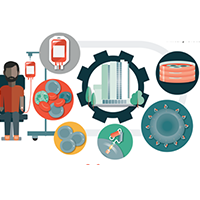Advances in using CAR-T cell therapy to treat HIV
Cell Gene Therapy Insights 2018; 4(4), 357-362.
10.18609/cgti.2018.034
What are the current therapeutic approaches to treating HIV and how effective are they?
Currently there are highly effective therapies to treat HIV infection using antiretroviral drugs. The development of these has been a really remarkable achievement in the history of HIV infection. When administered and taken properly, they can fully supress the virus in most individuals for long periods of time.
However, antiretroviral therapy isn’t a cure, it doesn’t eradicate the virus from the body. In addition, there are many issues associated with taking these drugs. For instance, they must be taken every day for a lifetime; and, if they’re skipped, the virus will appear in the blood and drug resistance can develop. There are also toxicity issues associated with antiretroviral drugs in certain individuals.
There has only been one instance where a treatment strategy has cured an individual. It involves a very cumbersome and laborious process involving bone marrow transplants with cells that are refractory to most strains of HIV. This procedure has been tried many times following the cure without success. However, the fact that one individual was cured has provided insights to many different aspects of how to potentially eradicate HIV infection.
Can you tell us a bit about the history of using CAR-T to treat HIV?
The development of CARs for HIV was first reported more than 20 years ago. In the mid to late 1990s, Margo Roberts and her colleagues at Cell Genesys constructed a CAR-T cell receptor containing human CD4 linked to the signalling domain of the T cell receptor zeta chain (it was also called the universal T cell receptor). They took cells out of the infected individuals, modified them with a retroviral vector that contained this CAR, and then put them back in these individuals. Although they did not see any major success in lowering the levels of virus in the treated individuals, the study provided some big insights into the future use of CAR technologies in many fields.
The cells were able to respond; however, the treatment failed due to a few possible reasons. Firstly, the cells were taken out and cultured extensively ex vivo and put back in, which might have functionally impaired them. Secondly, because the CD8 cells now had the CD4 on them, these cells might have got infected and were killed by the virus because CD4 is the receptor for HIV infection. Thirdly, most of these individuals were on antiretroviral therapy and so they might not have had a lot of virus for the CAR-T cells to respond to. This would have resulted in a modest response at best, and they weren’t able to significantly dent the levels of virus in these individuals.
However, what we were able to obtain out of that study is that the use of this CAR appears to be safe in the long term. The treated individuals have been followed for decades now and there have been no signs of major toxicities associated with the use of this approach. In many of these individuals, the CARs still persist and are detectable and safe.
You are using CAR engineered hematopoietic stem cells (HSCs) in your approach. What are the benefits and pitfalls associated with using HSCs as a starting material?
The use of hematopoietic stem cells or a stem cell-based approach has several advantages over a T cell approach. The T cell approach involves modification of mature peripheral T cells obtained from blood with a CAR. They’re modified and put back in, and these T cells generally have a limited lifespan and can have functional issues.
With a stem cell-based approach, when engrafted successfully, modified HSCs can offer long-term, stable and continuous production of genetically modified CAR-T cells. HIV is a chronic, long-term infection, so continuous production of HIV specific T cells would provide long-term immunity to HIV. We are attempting a combination of two different approaches using HSC-based therapies targeted at eradicating HIV. One approach modifies developing immune cells to produce cells that are resistant to HIV infection, while the other approach redirects cells to target and kill HIV-infected cells. In addition to T cells, we were able to generate NK cells using this method. That’s a bonus in the approach that these cells produce more than one cell type which can target and kill HIV.
A potential disadvantage is that this modification without any type of selection or suicide gene would be permanent for the individual. The long-term effects of this stem cell based approach aren’t known at this point. However, all our data thus far suggests that this modification and approach are safe.
How does using HSCs versus T cells as starting material affect the manufacturing process (in terms of time, costs etc)?
It’s roughly about the same, but the use of hematopoietic stem cells is less cumbersome. In the case of T cells, blood can be withdrawn the same day as the patient arrives. While, in the case of stem cells, the patient would receive a drug that would allow the stem cells in their bone marrow to be mobilised to the peripheral blood. These cells are then isolated from the peripheral blood on a different day. The upfront aspects of stem cell-based approach are more involved, in that blood would be withdrawn a couple of days after the patient has taken the drug.
The processing time and cost would probably be less for a stem cell-based approach than the T cell approach. This is largely because T cells need to be modified, cultured and expanded following isolation. It involves a much lengthier process. Whereas, in a stem cell-based approach, the cells are processed and reinfused back into the patient relatively quickly.
In both cases the patient would have to undergo some type of treatment that would create the space in the individual to allow engraftment of these cells to occur. We’re looking at optimized ways to do that for a stem cell-based approach.
From your study of long-term persistence and function of HSC-derived CAR-T cells in a non-human primate model of HIV, was there anything in particular that surprised you?
Although we rationalized that it could be done, it was surprising to see that the human CAR we put into non-human primates developed and responded normally as it did in human systems. CAR-containing cells persisted for more than 2 years without any measurable toxicity and were capable of multilineage engraftment.
The other aspect we were surprised at was that the response from these cells, once we were able to treat the monkeys with anti-retroviral therapy and release them, remarkably resulted in lower viral rebound. The cells in these animals contained the CAR and these cells were able to respond very robustly. Results showed that the HSC-derived CAR T-cells were capable of long-term engraftment and immune surveillance, which was a very promising outcome.
How far are we from seeing HSC-derived CAR-T therapies for HIV in clinical applications, and what needs to be demonstrated before we reach that point?
It’s difficult to put a timeline to that, but we are hoping to enter the investigational new drug (IND) status within the next 2-3 years. We are working on refinement of the CAR itself. We’re looking at ways to optimize the CD4-CAR so that it is more effective than the previous versions.
We’re also trying to optimize stem cell transplantation techniques. Until now our stem cell transplantation involved high dose myeloablation, which basically means that we heavily myeloablated these animals in an attempt to allow full reconstitution with the transplanted cells. When we go to the clinic in humans, we rationalise we don’t need high dose myeloablation. What we are testing are partial myeloablation techniques to really enable engraftment of CAR-modified stem cells in a way that doesn’t compromise the individual’s own immune response. We don’t believe we need to administer a full bone marrow transplant in these patients. Therefore, we’re looking at ways to mildly ablate and create enough space for modified cells to engraft and respond.
What do you see as the potential barriers for commercialization of HSCs to treat HIV?
The cost aspects of HSC-based therapies, like many therapies, will go down over time as they become more prevalent. The procedure involves modification of patients’ cells outside of the patients, and then reinfusion of the modified cells into the patients. Due to the complexity of the process, the treatment would be restricted to major medical centres at this point. It could be expanded in the future to outpatient clinics, because it could be done more or less as an outpatient procedure. However, this might be a major barrier in underdeveloped countries as it involves several days to treat.
To fully enable this treatment for all we would have to come up with ways to more effectively deliver the CARs to stem cells in individuals in vivo without the extensive cell modification steps that are involved now. That’s our ultimate goal, to look at ways to deliver the CARs to stem cells in the patient’s body. It’s science fiction, not yet science fact. However, we are actively pursuing this goal.
Affiliation
Dr Scott G. Kitchen
Associate Professor of Medicine
Director, UCLA Humanized Mouse Core Laboratory
Division of Hematology/Oncology
The David Geffen School of Medicine
University of California, Los Angeles.
This work is licensed under a Creative Commons Attribution- NonCommercial – NoDerivatives 4.0 International License.


